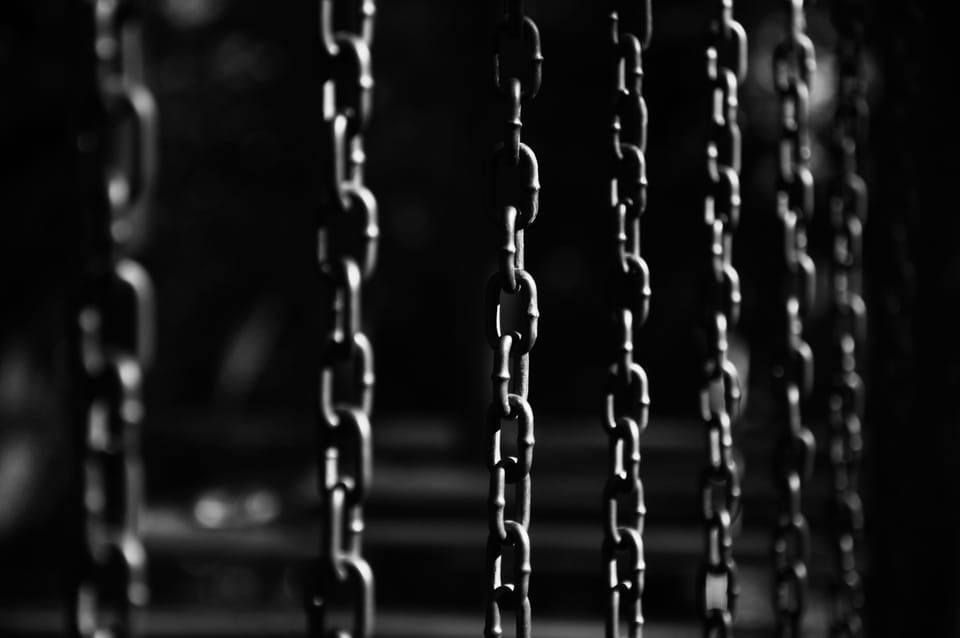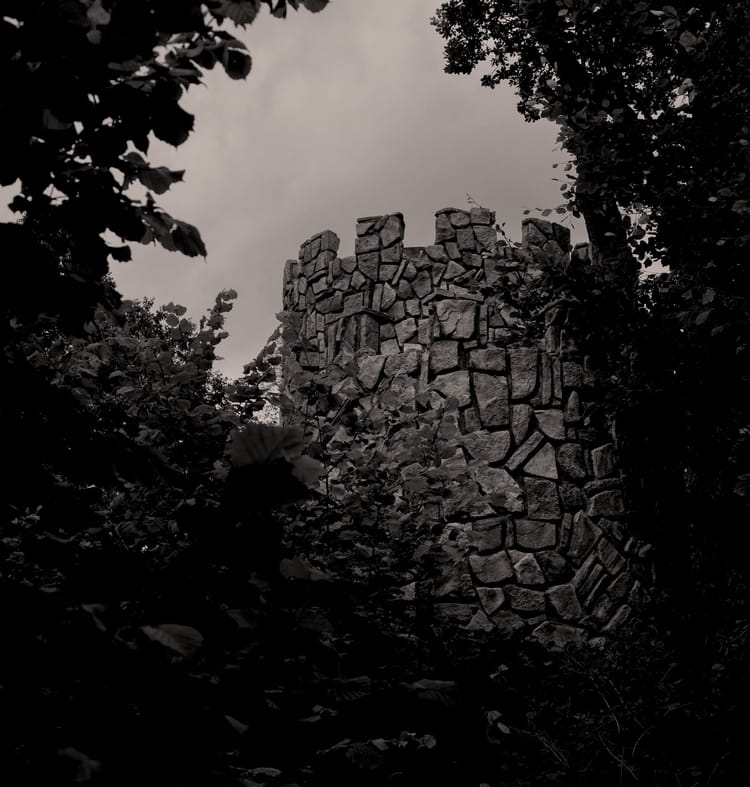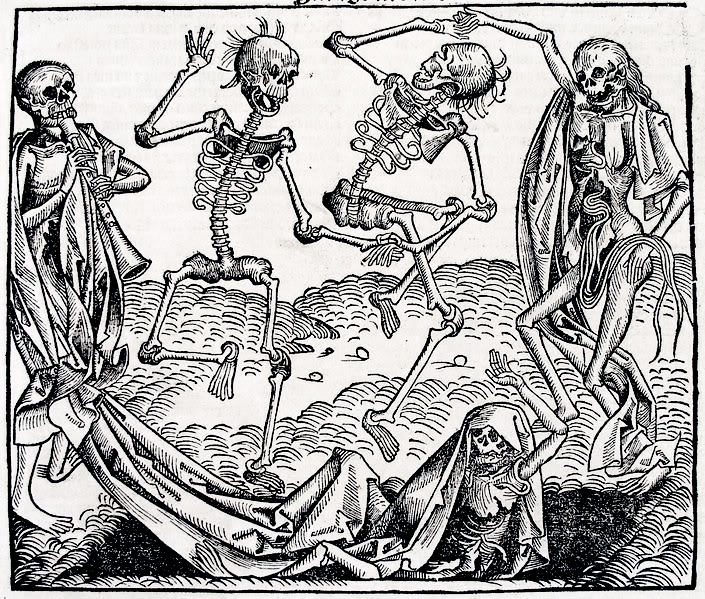New Moon: Ordeal by bondage

It's Friday, and our household is starting to bring in the cucumbers and the tomatoes. Hello.
I never write as much here about kink as I tend to feel that I should, although the sum total of posts I've given the "kink" tag is also much larger than I would have expected. Either way, when I bring up kink I'm aware that most of the people who actually receive this newsletter via e-mail are not themselves kink practitioners, or not that I know about. This has led me to try not taking any premises about kink for granted. A lot of my kink focus here has been elementary; it's integrated with my fundamental beliefs around ecstasy, ordeal, and violence, or I may lay out my version of kink 101 and overviews of visible ordeal processes like sensation play and impact play. It will probably be some time longer before I feel ready to write about more "advanced" kink topics here — instead confining those thoughts, regrettably, to FetLife — and it will also depend on whether any readers are desperate for more on this front.
But there are still many rudimentary kink principles and practices that I haven't already discussed, and I write about these as they occur to me. Lately, one idea in my head has been the matter of bondage as its own self-contained ordeal. This is basic knowledge on some level within many formal kink communities, especially groups centered around the kind of rope bondage that either qualifies as or is (in)directly inspired by Japanese kinbaku. To outsiders, however, I think there is still a popular media image of erotically tying someone up as the means to some other end, like whipping them; or people may be familiar with decorative rope harnesses, which serve an aesthetic end but do not restrict movement or cause pain. And these uses of bondage certainly exist in kink, but there are many sorts of consensual suffering that can come about through simply being bound in certain ways, and these form the avenue by which bondage can become ordeal work. Ordeal can come not only from dynamic, violent movement, but also from perfect stillness.
Bondage risks, summarized
Bondage is frequently considered an entry-level activity in kink and forms part of the umbrella BDSM acronym. Anyone can buy fuzzy or police-style handcuffs in relatively vanilla sex shops, "rope 101" classes are common fare at kink conventions; and because it's easier to photograph the end result of tying someone up than it is to photograph someone being beaten, there are many, many beautiful photos of people who have been tied. However, these days I think it's impossible to ethically open a discussion about bondage without calling attention to how — whether using rope or a different medium — bondage is not just sexy, pretty, and easy to learn.
It can be all of those things, but besides the dozens of kinksters I know who will readily confess their spatial reasoning and hand-eye coordination skills are not up to the task of tying rope, there are lots of effective ways to restrain someone that are not actually safer ways, and even when someone is restrained as safely as possible there are broader situational concerns that may not be accounted for. Here is a not even terribly comprehensive list of hazards that apply to all flavors of bondage — and sometimes especially to rope.
- Muscle, joint, and tendon/ligament injuries can occur for any limb(s) that have been restrained in a less than ergonomic fashion, or if the restrained person chooses to struggle in place.
- Nerve injuries, often temporary but sometimes permanent, can occur for any nerve that's compressed. Beginner rope bottoms are ideally counseled to learn their own body's signs of a compressed nerve; seasoned rope bottoms still often acquire at least one nerve injury to tell people about. The radial nerve and ensuing wrist drop is a classic offender.
- Other physical damage and dangers can arise from the restriction of blood flow to a given body part, or even from staying sedentary for a while, particularly for people with various pre-existing health conditions. Bondage is typically contraindicated for anyone with a heightened blood clot risk, and if still pursued it might at least be wise to closely limit the duration of the scene.
- If someone is not only bound but hung in the air, such as in rope suspension, all of the above risks are increased due to gravity increasing the pressure by any restraints on the body. There's then the additional risk of traumatic injury from falling out of the restraints if they aren't snug and secure in relation to themselves, or from failure of the hard point used for suspension.
- If someone is unable to escape from the bondage themselves, then there is enormous risk in leaving them unattended for any length of time. Even when the risk is functionally minimal, there can be legal liability insofar as physically trapping someone breaks some states' and municipalities' fire codes.
- Some positions used to restrain people in kink are stress positions that are otherwise used as a torture technique — extremely painful and very likely to cause injury when held for a long time period.
- Some positions (whether combined with dehydration/low blood sugar/etc. or occurring on their own) are known to cause vasovagal syncope or asphyxiation. Many fainting cases happen in rope suspension when someone is suspended perfectly upright, and while scholarly consensus is in some doubt it's been speculated that crucifixion kills through gradual difficulty inhaling.[1]
- Rope moved quickly across the body can of course cause rope burn, and though most compression-related bruising heals quickly there is always some hematoma risk.
- Being physically restrained can induce feelings akin to claustrophobia in some people, at times unexpectedly.
- For people like me who feel a comforting endorphin rush from being restrained, this can impair judgment.
- Letting someone restrain you means necessarily giving up the means to escape whatever they might physically do to you that you wouldn't normally consent to. Ethical bondage requires enormous trust, and I run across a disproportionate number of accounts around violated consent where bondage was involved.
I will not say that bondage is inherently higher-risk than extreme impact play, because everything comes down to individual risk profiles. However, I strongly agree with fellow kinksters who advocate for bondage being treated as higher-risk than it usually is, particularly where rope suspension is concerned. Some of us assert quite emphatically that suspension is edgeplay[1], and learning it should at least be taken as seriously as circus arts. In terms of my own risk profile, I am much more hesitant to be tied up by someone new than to let them inflict uncomfortable sensations on my body while I'm free to escape.
As with any kink, though, it's from an understanding of bondage risks that we can then very naturally move to looking at why bondage lends itself to ordeal.
Where the ordeal arises
So far, when I'm bound with rope or otherwise restrained, I do prefer positions and techniques that are on the "lower-risk" end of the spectrum, and I'm a stickler for basic precautions like safety scissors and being able to verbally communicate about sensations in my body (so no gags, or at least not for very long). But simultaneously, I'm a masochist, so while I enjoy wearing decorative rope and experiencing the pure sensual feeling of my owner dragging the rope over my bare skin, I have a distinct fascination with torturous bondage that leans in to some of the same factors that pose physical risks.
The risks notwithstanding, I love feeling rope dig into the fleshy parts of my figure, leaving little bruising bites behind. I love rough, natural fiber that's admittedly more likely to cause abrasions. Beyond just rope, I like the proverbial kiss of cold, unforgiving metal and have enjoyed an experiment or two in an iron pillory. I love the endurance challenge of holding a difficult position — I'm fascinated by bondage predicaments most of all, where the body is bound to itself or to hard points in a manner where trying to make one body part more comfortable causes extra strain and pain to another. While I have yet to really top for bondage, I'd like to design creative predicaments for others, too.
When holding still, powerless to do otherwise, in my experience something terrifying and freeing gradually develops. It's sensory deprivation of a kind, even with the eyes and ears left open. Because I cannot move, I grow equally more and less aware of my surroundings, forced to pay attention to how my body may come into contact with things but also distanced from my body because of how little it can do. I also grow equally more and less aware of myself; every twinge and ache feels significant and worth monitoring, yet I also have to transcend most sensations because there is only so much I can do to address them myself. I retreat into a space of the mind while being perpetually confronted with my corporeal nature.
Within this paradox, an altered state of consciousness coalesces, and this facilitates ordeal insofar as the activity becomes ecstatic. I have nowhere near the familiarity with intentional rope ordeal that some people do, but generally I will slip into a ritualistic, ordeal-compatible headspace rather fast when I'm being tied — compared to the longer, fiercer effort of flogging me into a high, overwhelming though that is. I have no question why the Hanged Man is the ultimate card representing trial, dissolution, the plumbing of difficult mysteries. I've been suspended exactly once, and in those minutes I discovered the basic truth of suspension that's impossible for still photographs to convey: the hanging body becomes a living pendulum.
But suspension is only one means to enter that trance (or near-trance). While my owner and I don't choose bondage as often as we choose a few other kink modalities — and while we find that bondage has seasonal timing, just like some of those other modalities do[3] — we've tied together enough times over the years that I've learned I respond strongly just to being restrained on a bed, the floor, or against a post. These situations can be sufficient for developing a somatic resilience akin to the patient discipline I've also found in yoga[4]. Even though kink is not an adequate substitute for therapy, I suspect that if I spent more time bound up, constantly slipping between hyper- and hypo-awareness of my body, I might grow more tolerant of unusual but benign sensation than I currently am, while remaining able to precisely speak up when something is wrong.
The ordeal is, at its core, not so different from weathering the lash, the cane, the claws, the ice, the wax. Not so different from ingesting the hallucinogen. The lesson is perpetual: this too shall pass.
I should note that to find such depths in a bondage scene demands an exceptional degree of trust in the bondage top. It goes further than trust that they will honor what was negotiated for the scene once the bottom is restrained, that they will offer no surprises the bottom isn't prepared to accept. This trust involves the awareness that communication and connection with the top can be maintained as fully as possible at all times. I must feel utterly certain that I'm in good hands, that mistakes will be dealt with. This creates a reciprocal obligation from the bottom to the top, too: I must demonstrate I'm capable of speaking up, being open, being vulnerable, otherwise this puts the top under pressure to either make uninformed decisions on my behalf or hesitate about everything.
Lastly, there is a politically complicated history to most erotic bondage mechanisms, and I find it both interesting and important to actively engage with that past, whether during a scene or when studying and preparing. When it comes to ropework, so much is mechanically, aesthetically, and intellectually owed to kinbaku (alternately called shibari) that there's a widespread problem of white/"Western" rope tops and bottoms who can't seem to respectfully mind the line between cultural appreciation and cultural appropriation. I'm absolutely intrigued by kinbaku styles like semenawa, which is essentially torture rope, and I also think it's reasonable to use Japanese names for types of rope ties that were first popularized in Japan; furthermore, if anyone could ever hold authority over which aspects of kinbaku can be practiced by non-Japanese, I'm one of the last people who should be considered for making those rulings. But I mistrust the orientalism and exoticization that often crops up in North American or European kinbaku scenes, and I tend to feel like over here we always have a few too many people staging photoshoots and performances with uncomfortably unexamined use of kimono, tatami, bamboo.
That problem aside, though, kinbaku has its fair share of internal controversy about whether the rope ties in question have a centuries-old lineage in an erotic context, were actually just invented in the mid-20th century, or something in between — a modern embellishment on the earlier martial art of hojōjutsu. From what I understand, I lean toward this last explanation, but then this places kinbaku's roots on the same continuum of non-kinky, nonconsensual policing and torture practices that have also given us cuffs, shackles, stocks, pillory, rack, strappado. What does it mean to claim these things in a kink context? What does it mean to willingly submit to these carceral tokens, in a world where prisons remain?
Proceeding further
These are just some morsels of thought, for the most part. I would have more to say if I had undergone more deliberate bondage ordeals, if I'd conducted any, or if I at least had more thorough experience with "nastier" bondage than my more careful forays to date. However, I've hoped this might still be an eye-opening read for the unfamiliar, and as I periodically engage in further bondage I would like to leave myself with the questions I just asked above, as well as:
What might some precise stages of a ritual bondage ordeal involve for me personally, whether as the bottom or the top?
What are the advantages of using rope for ordeal work, versus using other bondage implements?
If trying to mitigate risk in a bondage scene for ritual/ordeal purposes, how well can simulating a "high risk" situation achieve the same effect as an actual high risk situation?
And if you do have enough experience in this area to comment, I would love to read your own perspective.
[1] I think that even if the asphyxiation hypothesis has been discredited, crucifixion still must present a syncope risk after holding the same pose for such a long time, and this could prove lethal under the right conditions.
[2] Edgeplay is of course a vague, ever-shifting category of kink activities, but my personal definition is "any type of kink play where it is notably difficult or impossible to significantly reduce risk of death, severe injury, permanent disability, long-term trauma, or cumulative negative psychological effects." What qualifies as notable or significant can still be in the eye of the beholder, but some fairly indisputable examples in my opinion (besides suspension) include choking play, drowning play, play with loaded firearms or sharp knives, "consensual nonconsent" scenes, and any kind of D/s power exchange that deliberately mimics abusive relationships or family dynamics. I will personally engage in some of these things and never at all in others.
[3] In our dynamic, heavily sadomasochistic activities (especially impact) belong to the dark half of the year, and more sensuous, gentle activities belong to the light half. Because of the manner in which we currently tend to play with rope, "rope season" is usually the light half as well. That said, more torturous, ordeal-oriented rope feels like it belongs to the dark half; alternately, during the dark half we may reach more often for "quick," pragmatic bondage tools like cuffs or tape.
[4] Here is my repeated disclaimer about how I practice only a very diluted, fitness-oriented descendant of haṭha yoga, and I'm sure that the benefit I receive from it is simultaneously legitimate and quite different from what benefits I might receive if I practiced haṭha yoga in its totality within the contexts of a familially inherited Vedic religion.
This post was on the shorter side, but after a few weeks of long material I gave myself a rest. Thank you for reading, in any case. Next week there will be something more substantive as I catalogue the seasonal doings of local wild and domestic plant life on Calan Awst (Lughnasadh). After that, Moon phase timing will give us a second First Quarter post for paid subscribers, with reflections on making jam and preserves.





Member discussion